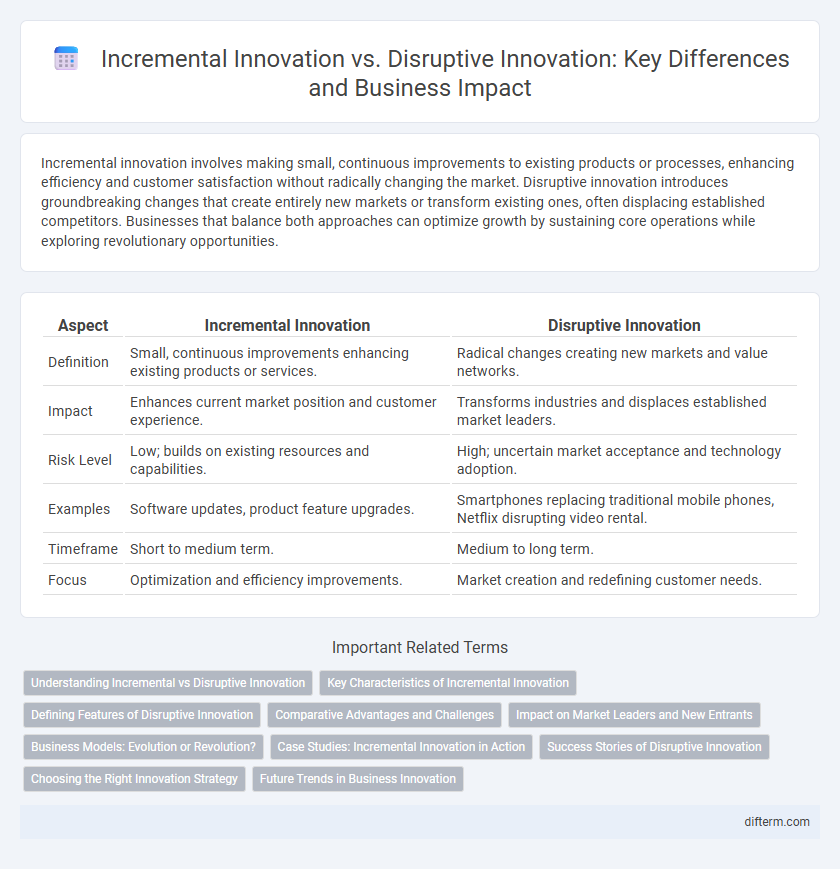Incremental innovation involves making small, continuous improvements to existing products or processes, enhancing efficiency and customer satisfaction without radically changing the market. Disruptive innovation introduces groundbreaking changes that create entirely new markets or transform existing ones, often displacing established competitors. Businesses that balance both approaches can optimize growth by sustaining core operations while exploring revolutionary opportunities.
Table of Comparison
| Aspect | Incremental Innovation | Disruptive Innovation |
|---|---|---|
| Definition | Small, continuous improvements enhancing existing products or services. | Radical changes creating new markets and value networks. |
| Impact | Enhances current market position and customer experience. | Transforms industries and displaces established market leaders. |
| Risk Level | Low; builds on existing resources and capabilities. | High; uncertain market acceptance and technology adoption. |
| Examples | Software updates, product feature upgrades. | Smartphones replacing traditional mobile phones, Netflix disrupting video rental. |
| Timeframe | Short to medium term. | Medium to long term. |
| Focus | Optimization and efficiency improvements. | Market creation and redefining customer needs. |
Understanding Incremental vs Disruptive Innovation
Incremental innovation involves gradual improvements to existing products, services, or processes, enhancing efficiency and customer satisfaction without altering the market landscape significantly. Disruptive innovation introduces groundbreaking changes that create new markets or transform existing ones, often rendering established technologies or business models obsolete. Understanding the distinction allows businesses to balance sustaining innovation with pioneering breakthroughs to maintain competitive advantage and drive long-term growth.
Key Characteristics of Incremental Innovation
Incremental innovation is characterized by continuous improvements and refinements to existing products, services, or processes, enhancing value without radical changes. It leverages existing technology and market knowledge to reduce risk and cost, promoting steady growth and competitive advantage. This approach supports sustainable development by meeting evolving customer needs while maintaining operational stability.
Defining Features of Disruptive Innovation
Disruptive innovation is characterized by introducing groundbreaking products or services that create new markets and significantly alter existing industries. It often targets overlooked customer segments with simpler, more affordable solutions, eventually displacing established competitors. This type of innovation leverages emerging technologies to drive rapid market transformation and long-term competitive advantage.
Comparative Advantages and Challenges
Incremental innovation offers businesses steady improvements with lower risk and easier integration into existing systems, enhancing efficiency and customer satisfaction without major upheaval. Disruptive innovation can create significant market advantages by introducing breakthrough products or services that redefine industry standards but often faces high uncertainty and resistance from established stakeholders. Balancing incremental and disruptive approaches enables companies to sustain growth while exploring transformative opportunities in competitive markets.
Impact on Market Leaders and New Entrants
Incremental innovation allows market leaders to refine existing products, maintaining competitive advantage through continuous improvements and customer retention. Disruptive innovation often enables new entrants to challenge incumbents by introducing novel business models or technologies that address unmet needs or lower-cost alternatives. Market leaders must balance sustaining innovation with strategic adaptation to potential market shifts driven by disruptive entrants.
Business Models: Evolution or Revolution?
Incremental innovation in business models emphasizes gradual improvements that enhance existing processes, products, or services, fostering steady growth and risk mitigation. Disruptive innovation, by contrast, radically transforms business models, creating new markets and value networks that render established models obsolete. Evaluating incremental versus disruptive approaches enables companies to balance evolutionary refinement with revolutionary change to sustain competitive advantage.
Case Studies: Incremental Innovation in Action
Incremental innovation drives steady growth by enhancing existing products and processes, as seen in Apple's continuous improvements to the iPhone series, which maintain customer loyalty and market relevance. Toyota's refinement of the hybrid technology in the Prius exemplifies incremental innovation, enabling sustained competitive advantage without drastic market shifts. These case studies demonstrate how incremental innovation fosters long-term value creation through gradual enhancements and operational efficiencies.
Success Stories of Disruptive Innovation
Disruptive innovation success stories include companies like Netflix, which transformed the entertainment industry by shifting from DVD rentals to streaming, fundamentally changing consumer behavior. Airbnb revolutionized the hospitality sector by leveraging technology to create a global peer-to-peer lodging marketplace, challenging traditional hotel models. Tesla disrupted the automotive market by introducing electric vehicles with advanced battery technology, accelerating the shift towards sustainable transportation.
Choosing the Right Innovation Strategy
Selecting the appropriate innovation strategy hinges on aligning business goals with market dynamics and resource capabilities. Incremental innovation enhances existing products or services by optimizing features and processes, fostering steady growth and customer retention. Disruptive innovation targets new markets or creates entirely novel value propositions, requiring higher risk tolerance but offering potential for significant competitive advantage and market transformation.
Future Trends in Business Innovation
Future trends in business innovation emphasize the growing importance of integrating incremental innovation with emerging digital technologies such as AI, IoT, and blockchain to enhance efficiency and customer experience. Disruptive innovation continues to reshape industries by enabling entirely new business models and market ecosystems, particularly in sectors like fintech, healthcare, and renewable energy. Companies adopting a hybrid approach that balances sustained improvements with strategic breakthroughs position themselves for sustained competitive advantage in rapidly evolving markets.
Incremental Innovation vs Disruptive Innovation Infographic

 difterm.com
difterm.com